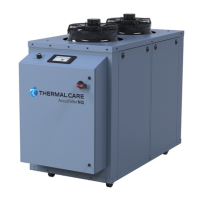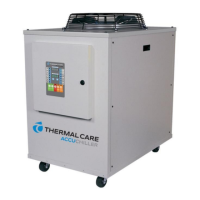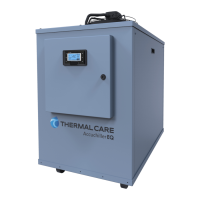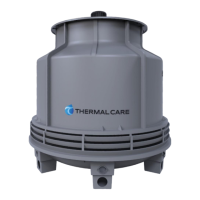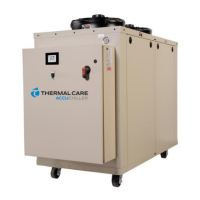
Do you have a question about the Thermal Care NQ Series and is the answer not in the manual?
| Brand | Thermal Care |
|---|---|
| Model | NQ Series |
| Category | Chiller |
| Language | English |
Explains safety symbols, warnings, and cautions for safe operation.
Provides detailed specifications for air-cooled chiller models.
Provides detailed specifications for water-cooled chiller models.
Lists specifications for remote air-cooled condenser chiller models.
Details electrical data for remote air-cooled condenser units.
Instructions for verifying unit correctness, condition, and documenting damage.
Recommendations for proper storage of the chiller to prevent damage.
Guidelines for chiller placement, mounting, and clearance for serviceability.
Safe methods for moving and positioning the chiller unit.
Best practices for installing chilled water piping to prevent condensation.
Illustrates recommended overhead piping configuration with a vacuum break.
Graph showing pump discharge pressure vs. flow for 4-ton chillers.
Graph showing pump performance for 4-ton high-flow chillers.
Graph showing pump discharge pressure vs. flow for 5-ton chillers.
Graph showing pump performance for 5-ton high-flow chillers.
Graph showing pump discharge pressure vs. flow for 7¹⁄₂-ton chillers.
Graph showing pump performance for 7¹⁄₂-ton high-flow chillers.
Graph showing pump discharge pressure vs. flow for 10-ton chillers.
Graph showing pump performance for 10-ton high-flow chillers.
Graph showing pump discharge pressure vs. flow for 13-ton chillers.
Graph showing pump performance for 13-ton high-flow chillers.
Graph showing pump discharge pressure vs. flow for 15-ton chillers.
Graph showing pump performance for 15-ton high-flow chillers.
Graph showing pump discharge pressure vs. flow for 20-ton chillers.
Graph showing pump performance for 20-ton high-flow chillers.
Graph showing pump discharge pressure vs. flow for 25-ton chillers.
Graph showing pump performance for 25-ton high-flow chillers.
Graph showing pump discharge pressure vs. flow for 30-ton chillers.
Graph showing pump performance for 30-ton high-flow chillers.
Graph showing pump discharge pressure vs. flow for 35-ton chillers.
Graph showing pump performance for 35-ton high-flow chillers.
Graph showing pump discharge pressure vs. flow for 40-ton chillers.
Graph showing pump performance for 40-ton high-flow chillers.
Graphs showing coolant circuit pressure drop for 4 and 5-ton chillers.
Graphs showing coolant circuit pressure drop for 7¹⁄₂ and 10-ton chillers.
Graphs showing coolant circuit pressure drop for 13 and 15-ton chillers.
Graphs showing coolant circuit pressure drop for 20 and 25-ton chillers.
Graphs showing coolant circuit pressure drop for 30 and 35-ton chillers.
Graphs showing coolant circuit pressure drop for 40-ton chillers.
Discusses factors affecting condenser performance and water treatment.
Graph showing pressure drop for water-cooled condensers (5-15 ton).
Graph showing pressure drop for water-cooled condensers (20-40 ton).
Specifies requirements for outdoor condenser placement and clearances.
Instructions for attaching legs and lifting smaller remote condensers.
Instructions for attaching legs and lifting larger remote condensers.
Details on connecting chiller and remote condenser refrigerant lines.
Key factors like distance, elevation, and drop legs for piping design.
Diagrams illustrating condenser placement relative to the chiller.
Diagram showing condenser placement below the chiller unit.
Method for calculating equivalent pipe length for line sizing.
Rules and considerations for sizing liquid refrigerant lines.
Table providing liquid line sizing based on equivalent length and riser height.
Table providing liquid line sizing for 20-35 ton circuits.
Table providing liquid line sizing for 40-ton circuits.
Guidance on sizing discharge lines for proper oil return and capacity.
Diagram illustrating vertical riser traps for hot gas lines.
Diagram showing a double discharge riser configuration.
Tables for horizontal/downflow and upflow discharge line sizing.
Tables for calculating total and field piping refrigerant charges.
Procedure for determining the correct oil charge for the system.
Table detailing fan pressure settings for condenser fan control.
Guidelines for electrical wiring, voltage tolerance, and phase sequence.
Crucial safety warnings related to electrical hazards and components.
Table providing electrical data for NQA15, NQA20, NQA25 models.
Table providing electrical data for NQA20, NQA25, NQA30 models.
Table providing electrical data for NQA30 models.
Table for NQW10/NQR10, NQW15/NQR15 electrical data.
Table for NQW20/NQR20, NQW25/NQR25 electrical data.
Table for NQW30/NQR30, NQW35/NQR35, NQW40/NQR40 electrical data.
Table detailing electrical data for remote air-cooled condenser units.
Description of the controller's display, basic layout, and diagnostic lights.
How to use the Start and Stop buttons for chiller operation and cancellation.
Functionality of Alarm Silence/Reset and Compressor Running Hours buttons.
Operation of Pump Running Hours and Pump Test buttons.
Functionality of Display/Program, Up, and Down arrow buttons.
Explanation of Control Power and Autostart Signal LEDs.
Meaning of Compressor #1 and #2 status LEDs and related parameters.
Explanation of Temperature Limit, Phase Error, and Low Flow LEDs.
Explanation of Freezestat, Reservoir Level, Compressor Recycle, Refrigerant LEDs.
How the Set Point and Process displays show temperature and units.
Introduction to accessing and using the controller's program menu.
Step-by-step guide to entering and navigating the program menu with password.
Instructions for performing a master reset to factory default settings.
Table listing adjustable parameters, item codes, default values, and ranges.
Table detailing fault conditions, alarm indications, and reset requirements.
Explanation of the SPI communication standard used for integration.
Table of SPI parameters, commands, poll/select values, and descriptions.
Further SPI parameters including status, mode, and temperature readings.
Overview of the Modbus RTU option for RS-485 communication.
Table listing Modbus RTU parameters with integer values and notes.
Table listing Modbus RTU parameters with floating point values and notes.
Introduction to the optional PLC and touchscreen interface for chiller control.
Description of the initial screen and company contact details.
Overview of the primary screen for chiller control and navigation.
Explains the operation of Start and Stop buttons on the main screen.
Describes Alarms, Setup, Process, and Refrigeration diagnostic buttons.
Details on Compressor Setup, Process Setup, PID, and FreezeStat screens.
Explanation and adjustment of PID parameters for hot gas bypass.
How to adjust Freezestat settings for freeze protection.
Displays operating status of coolant temp, pump, and HGBP valve.
Shows digital inputs/outputs and allows navigation to output designation.
Displays operating status of set point, actual temps, HGBP, compressor.
Importance of preventive maintenance and suggested schedule.
Tasks to perform weekly, including checks on condenser coils and temperatures.
Tasks to perform monthly, including electrical connections and voltage checks.
Tasks to perform quarterly, including Y-strainer cleaning and technician inspection.
A checklist for tracking scheduled maintenance activities.
Common causes and remedies for compressor and pump start failures.
Troubleshooting for high or low refrigerant pressure problems.
Solutions for freezestat faults and low flow conditions.
Troubleshooting for erratic temperature control and insufficient cooling.
Instructions for connecting main power and checking phase sequence.
Steps for filling the coolant reservoir with water or glycol solution.
Discusses water properties, potential issues, and necessary treatments.
Table listing water characteristics and their quality limitations.
Table recommending glycol concentrations for different chilled water temperatures.
Procedures for checking integral, water-cooled, and remote condensers.
Verify that all refrigerant service valves are open.
How to set the Freezestat appropriately for operating conditions.
Instructions for turning on control power and resetting potential alarms.
How to establish coolant flow through the chiller before operation.
Steps for setting temperature, checking pressures, and initial operation.
Details the standard warranty coverage for Thermal Care equipment.
Specifies conditions that may void the warranty or are not covered.
Details the terms and conditions for the optional extended compressor warranty.
